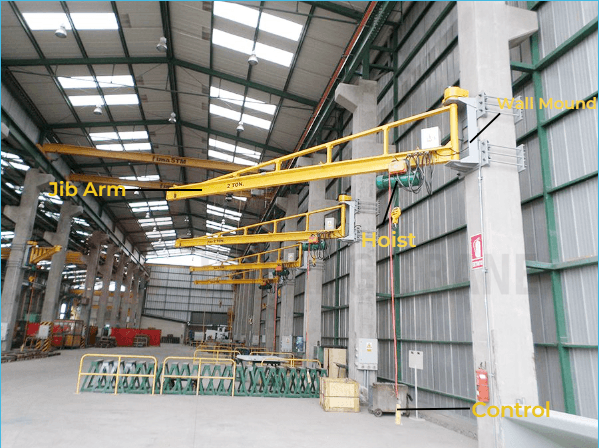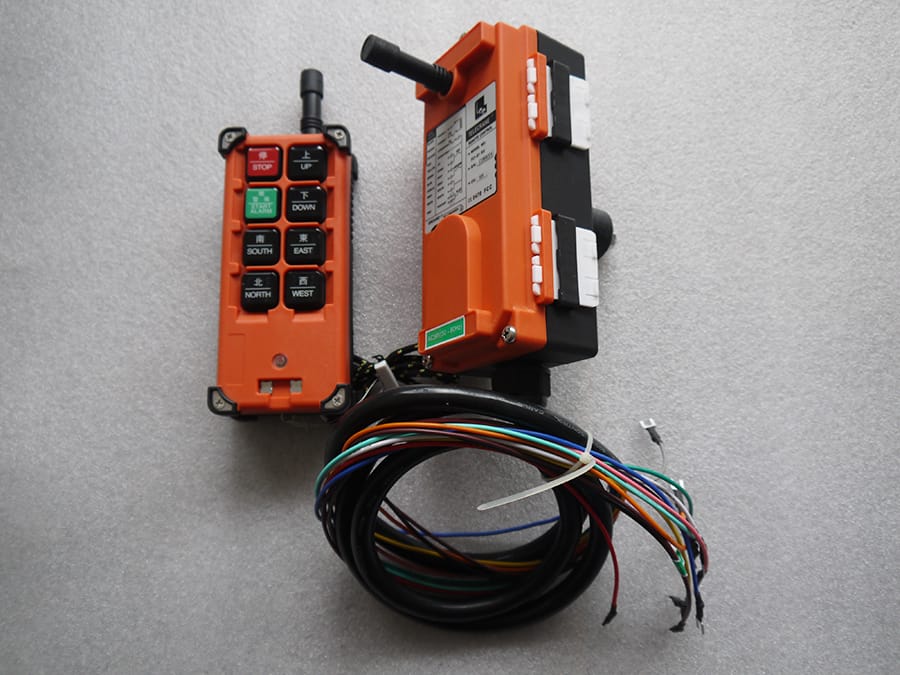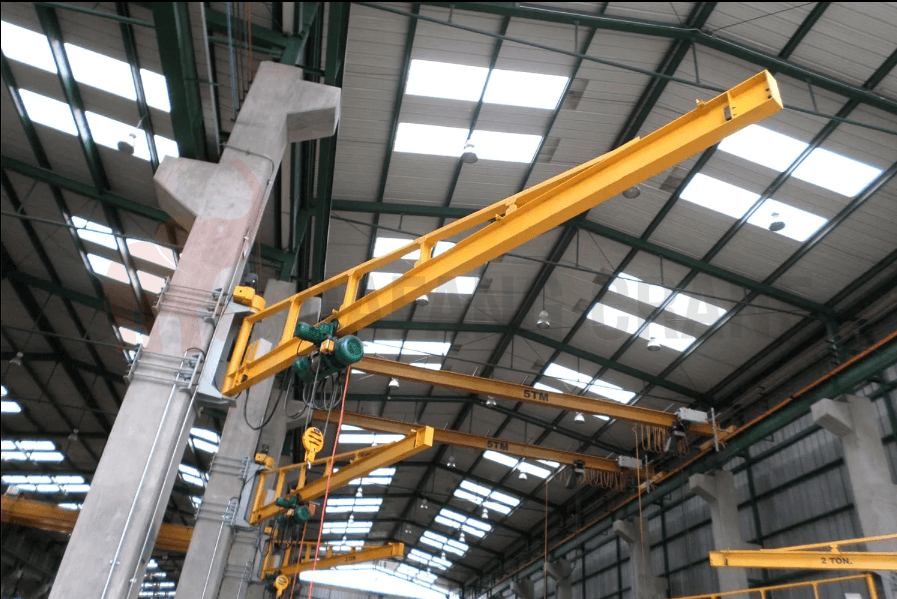Wall Mounted Jib Crane: How To Use It
Wall-mounted jib cranes are versatile lifting devices that offer convenience and efficiency in various industrial settings. These cranes are specifically designed to be mounted on walls, providing maximum utilization of limited space. In this article, we will explore how to use a wall mounted jib crane, including the concept of wall mounted jib cranes, their working principle, how to operate them effectively, and their applications in different industries.
What Is A Wall Mounted Jib Crane?
A wall mounted jib crane is a type of material handling equipment that consists of a horizontal beam (jib) mounted on a vertical support structure attached to a wall or column. The jib arm can rotate 180 degrees or even a full 360 degrees, depending on the specific design. This allows for easy maneuverability and precise lifting of heavy loads within a defined area.
The primary purpose of a wall-mounted jib crane is to provide localized lifting and positioning capabilities. It is especially useful in areas where floor space is limited, as it eliminates the need for freestanding support structures commonly found in traditional overhead cranes.
Working Principle Of Wall Mounted Jib Crane
The working principle of a wall mounted jib crane is relatively straightforward. The crane consists of several key components that work together to facilitate lifting operations. These components include:
- Wall Mount: The wall mount serves as the primary support structure for the crane. It must be securely attached to a load-bearing wall capable of withstanding the weight and forces generated during lifting operations.
- Jib Arm: The jib arm is the horizontal beam that extends from the wall mount. It provides the necessary reach and coverage area for moving loads. The jib arm can rotate along its axis, allowing for increased flexibility and precise positioning.
- Hoist or Trolley: The hoist or trolley is the mechanism responsible for lifting and moving loads along the jib arm. It typically consists of an electric or manual chain hoist, wire rope hoist, or electric trolley. The choice of hoist depends on the specific application requirements and load capacity.
- Controls: Wall-mounted jib cranes are equipped with user-friendly controls that allow operators to maneuver the crane with ease. These controls may include push-button pendant stations or wireless remote control systems.

When the jib crane is in operation, the cantilever is driven by the reducer gear or pull ring pushed by hand to realize the movement of the hoisted object. The rotation mechanism allows for precise horizontal movement, while the hoisting mechanism enables vertical lifting.
How To Operate A Wall Mounted Jib Crane
To operate the wall mounted jib crane safely, follow these steps:
Step 1: Pre-Operational Checks
Before using the crane, perform the following checks:
- Inspect the crane for any visible damage or defects.
- Ensure that the hoist/trolley system is in good working condition.
- Check the controls and emergency stop button for proper functionality.
Step 2: Positioning the Load
- Position the load within the crane’s lifting capacity and center of gravity limits.
- Attach appropriate slings or lifting devices securely to the load.
- Verify that the area around the crane is clear of personnel and obstacles.
Step 3: Operating the Controls
- Familiarize yourself with the crane’s control panel and functions.
- Use the control buttons to activate the hoist/trolley movement as needed.
- Follow the manufacturer’s instructions for specific control operations.

Step 4: Lifting and Moving the Load
- Gradually lift the load using smooth and controlled movements.
- Maintain a clear line of sight while moving the load to avoid collisions.
- Make small adjustments as necessary to ensure precise load placement.
Step 5: Finishing Operations
- Once the load is positioned correctly, lower it gently and secure it in place.
- Power off the crane and return the controls to their neutral positions.
- Perform post-operation inspections
Safety Precautions
When operating a wall mounted jib crane, it is vital to follow certain safety precautions:
- Always wear appropriate personal protective equipment (PPE) such as helmets, gloves, and safety shoes.
- Keep a safe distance from the load and the crane during operation.
- Regularly inspect and maintain the crane to ensure optimal performance and safety.
- Verify that the load does not exceed the crane’s rated capacity.
- Use suitable slings or attachments to secure the load properly.
- Keep the surrounding area clear of obstacles to prevent accidents during operation.
Application Of Wall Mounted Jib Crane
- Warehouses and Distribution Centers: Mounted jib cranes are often used in warehouses and distribution centers to assist with material handling tasks. They can be used to lift and move heavy items such as pallets, crates, and containers, making loading and unloading trucks more efficient.
- Manufacturing and Assembly Lines: Jib cranes are commonly employed in manufacturing and assembly line operations. They can be utilized to lift and position components, tools, and equipment during the production process. The ability to rotate the jib arm allows for easy access to different workstations or assembly areas.
- Maintenance and Repair: Mounted jib cranes are valuable tools for maintenance and repair operations. They allow technicians to lift and move machinery or parts during servicing, inspections, or repairs. Jib cranes provide accessibility to different areas of equipment, facilitating maintenance procedures and reducing downtime.
- Workstation Assistance: Mounted jib cranes are often installed in individual workstations where repetitive lifting tasks are required. These cranes provide ergonomic assistance to workers by reducing strain and fatigue associated with manual lifting. They enable efficient and safe handling of components, tools, and equipment, enhancing productivity and minimizing the risk of workplace injuries.
Wall mounted jib cranes are versatile and efficient lifting devices that offer numerous benefits in various industrial settings. With their ability to be mounted on walls, these cranes maximize the utilization of limited space, making them particularly advantageous in areas where floor space is constrained. The working principle of a wall mounted jib crane is straightforward, with key components such as the wall mount, jib arm, hoist or trolley, and user-friendly controls working together to facilitate lifting operations. To operate the crane safely, pre-operational checks must be performed, the load must be positioned correctly, and the controls should be operated following manufacturer instructions. Safety precautions should always be adhered to, including wearing appropriate personal protective equipment and maintaining the crane’s optimal performance through regular inspections and maintenance. The application of wall mounted jib cranes spans across various industries, including warehouses, manufacturing and assembly lines, maintenance and repair operations, and workstation assistance, providing convenience, efficiency, and improved productivity while reducing the risk of workplace injuries.
Send Your Inquiry
- Email: sales@hndfcrane.com
- WhatsApp: +86-191 3738 6654
- Tel: +86-373-581 8299
- Fax: +86-373-215 7000
- Add: Changnao Industrial District, Xinxiang City, Henan Province, China








































































